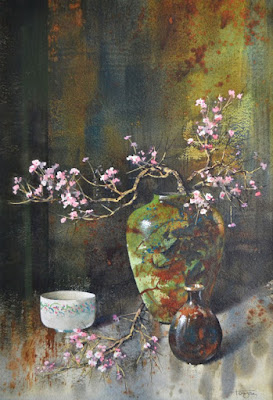Others frame their own watercolours. It's relatively inexpensive to buy standard frames and cut out your own mats. But how wide should the mat(s) be?
The width depends on the painting. Each one demands a different type and style of frame and mat. The important thing is to ensure that your work has room to breathe and doesn't look squished into a small mat or frame.
If you already have a frame in mind for your painting, then you don't need to decide how wide your mat should be to best present your art. The measurements are easy. The mat will extend to the edge of the back of the frame and overlap all sides of your painting by at least 1/4″.
Here is a table suggesting the size the mat for standard off-the-shelf frames and size of art. (https://watercolorpainting.com/matframe/)
FRAME SIZE
|
ART SIZE
|
MAT OPENING
|
5 x 7
8 x 10 9 x 12 11 x 14 12 x 16 14 x 18 16 x 20 16 x 20 18 x 24 18 x 24 20 x 24 20 x 27** 22 x 28 22 x 28 24 x 30 |
3 x 5
5 x 7 6 x 9 8 x 10 9 x 12 11 x 14 11 x 14 12 x 16 12 x 18 14 x 20 16 x 20 15 x 22 15 x 22 18 x 24 18 x 24 |
2 .75 x 4.5
4.5 x 6.5 5.5 x 8.5 7.5 x 9.5 8.5 x 11.5 10.5 x 13.5 10.5 x 13.5 11.5 x 15.5 11.5 x 15.5 13.5 x 19.5 15.5 x 19.5 14 x 21 14.5 x 20.5 17.5 x 23.5 17.5 x 23.5 |
However, if you are looking for a special effects you may start by planning the size of the painting and mat first, same as you would with composition. For example, an oversized mat can help set off a small piece.
In most cases the mat should be at least 2" to 2 1/2" wide. In my opinion a mat smaller than 2" wide doesn't look attractive.
When you use two mat boards for a special effect, the first one covers the margins of the watercolor paper and a very narrow part of the painting’s borders, creating a wide border with a window effect. Cut the second mat that will be laid on top of the first one with only a narrow part (1/8 to ¼ in.) of the first one showing.
If you are wondering why mat a painting, it's important to note that mats allow air to circulate around the work as well as give your artwork a nice inner frame.
When framing your painting, ensure you are using acid free products to prevent oxidation and aging. Acidic materials used in mats can lead to big problems such as the mat itself becoming yellowish in colour and deteriorating the colours within the painting that is in contact with the mat over a long period of time.
If you go to a museum and look at the prints and works on paper, you’ll notice one thing -- the absence of strong color in the mat. Most curators feel a colorful mat is a distraction to the art, and therefore go with cream, antique white or very soft neutral white shades—thinking these neutral choices make the image in the frame look more important. My advice is to choose color wisely. Go for tones that are either dominant in the image, or that draw out subtle colors in the piece—a color that seems to bring it all together. And keep in mind that stark white can be a killer if the white in the piece is not as stark as the mat color.
If you are framing your painting for a juried show, check out the rules. Many will only allow white or off-white mats.
If you are framing your painting for a juried show, check out the rules. Many will only allow white or off-white mats.
He is one of the founders of the Canadian Watercolour Society.
Have a great week
Danielle

No comments:
Post a Comment
Would love to hear from you:
Note: only a member of this blog may post a comment.